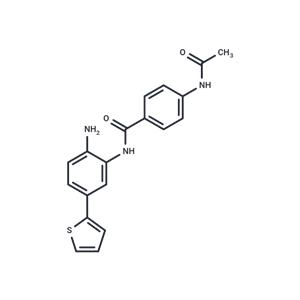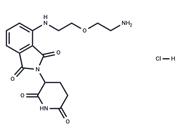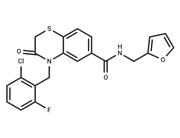| Name | BRD-6929 |
| Description | BRD-6929 is a selective, brain-penetrant HDAC1 and HDAC2 inhibitor (IC50: 1 and 8 nM). BRD-6929 (Cpd-60) shows high-affinity to HDAC1 and HDAC2 (Kis: 0.2 and 1.5 nM) [2]. BRD-6929 potentiates the efficacy of gnidimacrin (a PKC Agonist) against latent HIV-1. BRD-6929 can be used for mood-related behavioral model research[3]. |
| In vitro | In vitro IC50 for HDAC1-9 by BRD-6929 using recombinant human HDAC enzymes and HDAC class-specific substrates. BRD-6929 and substrate are incubated for 180 min (HDAC1-3) to control for HDAC1-3 inhibition, BRD-6929 is against HDAC1, HDAC2, HDAC3 and HDAC4-9 with IC50s of 0.001 μM, 0.008 μM, 0.458 μM and >30 μM, respectively[1].
In vitro binding affinity (Ki) and kinetics (half-life ‘T1/2′ in minutes) for HDAC 1, 2 and 3 incubated with BRD-6929 (10 μM), the Ki values are <0.2 nM, 1.5nM, and 270 nM for HDAC 1, 2 and 3, respectively. The T1/2 values are >2400 mins, >4800 mins, and 1200 mins for HDAC 1, 2 and 3, respectively[1].
BRD-6929 (1 and 10 uM) does not cause an increase or decrease in overall cell number in brain region specific primary cultures. Additionally, BRD-6929 (10 uM) causes an increase in H4K12 acetylation in brain region specific primary cultures (striatum)[1].
BRD-6929 (1-10 uM; 6 hours) causes a significant increase in H2B acetylation in primary neuronal cell cultures. BRD-6929 (1-20 uM; 24 hours) induces a dose-dependent acetylation of H4K12ac with an EC50 of 7.2 μM in cultured neurons[1].
BRD-6929 potentiates the efficacy of gnidimacrin (a PKC Agonist) against latent HIV-1[3]. |
| In vivo | BRD-6929, administered via intraperitoneal injection at a 45 mg/kg dosage, achieves peak plasma concentrations (Cmax) of 17.7 μM, has a half-life (T1/2) of 7.2 hours, and an area under the curve (AUC) of 25.6 μM/L*hr. In the brain, its Cmax, T1/2, and AUC are 0.83 μM, 6.4 hours, and 3.9 μM/L*hr, respectively. When given daily for 10 days at the same dose, BRD-6929 functions as a deacetylase inhibitor in mouse brain, elevating acetylation levels in various brain regions by 1.5- to 2.0-fold over the control. Specifically, it notably increases the acetylation of histone H2B (tetra-acetylated), H3K9, and H4K12 in the cortex, ventral striatum, and hippocampus of adult male C57BL/6J mice, as evidenced by western blotting after the 10th treatment[1]. |
| Storage | Powder: -20°C for 3 years | In solvent: -80°C for 1 year | Shipping with blue ice. |
| Solubility Information | DMSO : 4.9 mg/mL (14 mM), Sonication is recommended.
|
| Keywords | Inhibitor | mood-related | Human immunodeficiency virus | BRD 6929 | HDAC | HDACi | HIV | behavioral | BRD6929 | inhibit | Histone deacetylases | BRD-6929 |
| Inhibitors Related | Stavudine | 5-Fluorouracil | Emtricitabine | Kaempferol | Dolutegravir intermediate-1 | Sodium 4-phenylbutyrate | Dextran sulfate sodium salt (MW 4500-5500) | Lamivudine | Chloroquine phosphate | Curcumin | Decanedioic acid | Tenofovir |
| Related Compound Libraries | DNA Damage & Repair Compound Library | Anti-Pancreatic Cancer Compound Library | Bioactive Compound Library | Chromatin Modification Compound Library | Anti-Breast Cancer Compound Library | Anti-Viral Compound Library | Inhibitor Library | NO PAINS Compound Library | Anti-Aging Compound Library | Bioactive Compounds Library Max |

 United States
United States



